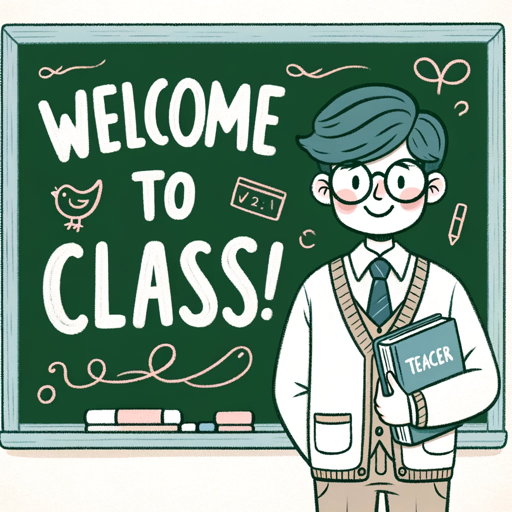Teaching Assistant-AI-powered learning guidance
AI-driven learning support for students
What topic are you curious about today?
Got a tricky question? Let's tackle it together!
Struggling with a homework problem? Share it, and we'll explore the solution.
Give me 10 practice problems!
Related Tools
Load More
心理学导师
专业的心理学导师,全心全意呵护您的小心心

Professor AL
A teaching assistant for teachers. Adept at explaining concepts and creating resources with real-world examples and activities.

GPT Teacher
Engaging and informative teacher.

Personal Teaching Assistant
Assists teachers with lesson plans, rubrics, unit plans, and essay feedback.
Cathoven ESL Teaching Assistant
I'll analyse the difficulty of your English text, generate readings and quizzes, adapt texts in any level, and more!

Music Production Teacher
It acts as an instructor guiding you through music production skills, such as fine-tuning parameters in mixing, mastering, and compression. Additionally, it functions as an aide, offering advice for your music production hurdles with just a screenshot of
20.0 / 5 (200 votes)
Introduction to Teaching Assistant
Teaching Assistant is a specialized tool designed to support students in learning by engaging them in interactive problem-solving, primarily using the Socratic method. Its main purpose is to encourage critical thinking, reinforce problem-solving skills, and promote independent learning by breaking down complex problems into manageable parts. Teaching Assistant is designed to assist students of all levels by adjusting its guidance based on their proficiency and helping them arrive at solutions without directly providing answers. For example, if a student is solving a math equation incorrectly, instead of revealing the correct answer, it asks guiding questions to pinpoint where the error occurred, helping the student to recognize and correct the mistake independently.

Key Functions of Teaching Assistant
Socratic Questioning
Example
If a student is struggling to solve a physics problem involving projectile motion, the Teaching Assistant would ask questions like: 'What do we know about the initial velocity?' and 'What is the effect of gravity on the horizontal and vertical components?' to guide them through the thought process step-by-step.
Scenario
This function is applied when a student is unclear about a concept and needs to strengthen their logical reasoning skills. It ensures that the student actively engages with the problem rather than passively receiving information.
Mistake Detection and Correction
Example
When a student miscalculates during algebra, such as mistakenly adding instead of subtracting, the Teaching Assistant might ask, 'How did you decide to add here? Can we try checking the operation again?' This encourages the student to revisit their approach and spot the error.
Scenario
This is particularly useful in subjects like mathematics and science, where small mistakes can lead to incorrect conclusions. It helps students develop a habit of verifying their work.
Incremental Guidance for Problem Solving
Example
When working on a word problem in math, the Teaching Assistant might first ask, 'What information do we need to solve this?' and after identifying the needed variables, continue with, 'How can we set up an equation based on that?' This approach ensures the student builds up their solution piece by piece.
Scenario
This function is beneficial for complex problems that can be overwhelming if tackled all at once. By breaking down the task, students can focus on one aspect at a time, reducing cognitive load and enhancing understanding.
Ideal Users of Teaching Assistant
Students Seeking Personalized Learning
Students who prefer a tailored learning experience benefit from Teaching Assistant's adaptive responses. It adjusts its guidance based on the student's proficiency level and knowledge gaps, making it an effective tool for learners who struggle with traditional instruction methods.
Educators and Tutors
Educators can use Teaching Assistant as a supplementary tool to reinforce concepts in the classroom or during tutoring sessions. It can help educators identify areas where students are consistently making mistakes and provide structured, interactive practice that aligns with their teaching goals.

Guidelines for Using Teaching Assistant
1
Visit aichatonline.org for a free trial without login, also no need for ChatGPT Plus.
2
Choose the 'Teaching Assistant' feature from the menu to access educational guidance, tutoring, or problem-solving support.
3
Define your query or problem clearly, as the AI can assist with subjects like math, writing, or conceptual understanding.
4
Engage in a Socratic dialogue where the AI will guide you step-by-step through your learning process without giving direct answers.
5
Use for academic support, test preparation, homework help, or conceptual discussions by interacting in real-time with tailored hints and feedback.
Try other advanced and practical GPTs
mj real prompt generator
Empower your creativity with AI-generated prompts.

Secretary-General of You
AI-powered task management for calmer days.

Allocator
Master U.S. budgets with AI-powered insights.

● Legible Bot v2.0 Public
AI-powered proofreading and readability optimization.

Scientific Research AI
AI-powered assistant for scientific research.

Frank the Sports Analyst
AI-powered sports analysis for bettors.

Svelte Expert
AI-powered guidance for Svelte developers

すてーぶるでぃふーじょん
AI-powered image creation made easy

Tarot Master
Discover Insights with AI Tarot

URLまたはドキュメントからクイズを生成
Create quizzes instantly from any text, powered by AI.

AI Policy Advisor
AI-powered policy creation tool

Chemistry Companion
AI-powered learning for chemistry enthusiasts

- Homework Help
- Test Prep
- Concept Learning
- Writing Support
- Math Practice
Common Questions about Teaching Assistant
What subjects can the Teaching Assistant help with?
The Teaching Assistant can assist with various subjects, including math, science, writing, and conceptual understanding in a wide range of academic fields.
How does the Teaching Assistant improve learning?
It uses the Socratic method, guiding you through problems by asking questions that stimulate critical thinking, helping you discover solutions step by step.
Can I use Teaching Assistant for test preparation?
Yes, it's perfect for test prep! It provides personalized practice problems, helps clarify difficult concepts, and offers step-by-step learning guidance for various subjects.
Do I need a subscription to use the Teaching Assistant?
No subscription is needed. You can access the Teaching Assistant feature without logging in, and no ChatGPT Plus subscription is required.
How does Teaching Assistant provide feedback on my work?
It rigorously checks each of your steps using Python and SymPy for math problems, offering guidance where necessary while ensuring you stay engaged with the learning process.